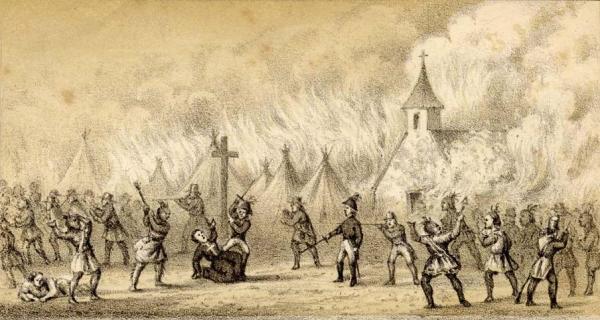This Date in Native History: On February 20, 1725, a group of 88 scalp hunters led by John Lovewell attacked a band of Abenaki Indians living in a wigwam near Wakefield, New Hampshire.
Motivated by state-sponsored programs that offered rangers payments for Indian scalps, the men tracked the Abenaki for 11 days then opened fire near midnight on February 20. Lovewell’s posse killed and scalped 10 men and received a bounty of 100 British pounds per scalp.
Part of Father Rale’s War—or the war between the Abenaki and the New Englanders—this incident marks one of the most celebrated times colonists scalped Indians in exchange for money.
“Bounty was a European innovation,” said Dean Snow, emeritus professor of anthology at Penn State University. “Scalping was used as financial credit for making the kill. It was the way to tally credits in warfare.”
Lovewell, who led three raids against the Abenaki, eventually earned the title of the most famous scalp hunter of the 18th century. Although he capitalized on the privatization of war, earning extravagant bounties for every Indian scalp he brought back, Lovewell was not the first colonist to practice scalping.
State-sponsored scalp hunting laws went into effect in the mid-1670s, John Grenier wrote in his 2005 book The First Way of War: American Warmaking on the Frontier.
In July 1689, at the start of King William’s War, the state of Massachusetts declared that each soldier would receive eight pounds out of the public treasury for each Indian scalp and that “whatever Indian plunder falls into their hands shall be their own.”
Less than a decade later, in 1697, a woman named Hannah Dustin became a Colonial heroine when she slayed her Abenaki captors while they slept—10 women and children—then redeemed their scalps for money. A bronze monument honoring Dustin stands in Haverhill, Massachusetts, her home state. Clutched in her right hand is a hatchet. Dustin was held in New Hampshire, where a granite monument stands. This one shows her with a hatchet and the scalps of the women and children.

This Hannah Dustin statue is in Haverhill, Massachusetts, her home state.
By 1702, Massachusetts offered 10 pounds for every scalp from a male Indian age 10 and older. That price increased to 20 pounds then 100, Grenier wrote. Scalps taken from women fetched 10 pounds each, while children under the age of 10 were sold into slavery with proceeds going to the scalp hunters.
“Scalp hunting provided both an effective and a financially rewarding means to kill, conquer and subjugate the Indian peoples of the Eastern Seaboard,” Grenier wrote.
Scalping, according to James Axtell, a former history professor at the College of William & Mary, was performed after a person was unconscious or dead. The executor, from a position behind the victim, pulled the hair back and used an obsidian blade to slice off a section of skin.
In some cases, scalps were displayed as badges of honor. Other times they were gifts or decorations, Axtell said. When there were bounties to be collected, scalps served as a way to count the dead.
One of the problems of scalping, however, was that taking a scalp did not guarantee death, Axtell said.

Craig Michaud/Wikimedia Commons
This statue is on the island in Boscawen, New Hampshire where Hannah scalped the Indians and escaped.
“It was fairly common to survive scalping,” he said. “There were medical journals that included articles about the care and management of a scalped head.”
The practice was similar to what Europeans did in warfare, Axtell said.
“Europeans were always taking heads,” he said. “If you take the whole head, there’s no doubt that person is dead and will stay dead. Scalping is not torture, just trophy-taking.”
Despite the evidence of colonists scalping Natives, the word “scalp” is culturally loaded, and most Americans assume the practice is rooted in Native tradition. Natives argue that the practice was learned from Europeans—possibly from traders who arrived centuries before Columbus—and used in retaliation against the colonists.
Anthropologists cite evidence that Natives were taking scalps long before Columbus arrived, Snow said.
“Europeans were busy burning each other at the stake or quartering people who were not yet dead,” he said. “Scalping was a prehistoric practice here among the Indians. We’ve got some evidence that it was going on 300 years before Columbus, but not in Europe.”
Axtell cites linguistic evidence to show that scalping originated among the Natives. Indian languages had words for scalping, along with customs that were unique to each tribe, he said.
Yet Native historians adamantly deny that First Americans took scalps before contact with Europeans. In a 2000 article that ran in the Boston Globe, representatives of two Eastern tribes denied the practice took place prior to the mid-1700s.
Mashantucket Pequot spokesman Buddy Gwin said scalping “was not a practice traditional to First Nations peoples” until becoming “a retaliatory act” against colonists. John Brown, of Rhode Island’s Narragansett Indians, said bodily mutilation was considered “dishonorable” until it was “learned” from Europeans.

In his 1969 manifesto, Custer Died for your Sins, Vine Deloria Jr. said Europeans likened Natives to wild animals.
“Scalping, introduced prior to the French and Indian War by the English, confirmed the suspicion that Indians were wild animals to be hunted and skinned,” he wrote. “Bounties were set and an Indian scalp became more valuable than beaver, otter, marten and other animal pelts.”
Regardless of how it started, the practice of scalping was losing popularity by the early 1800s, Snow said. Although there were some reports of scalping during the Revolutionary War and bounties were being offered as recently as the Civil War, the act of scalping posed a moral dilemma.
“By the end of the 1700s, practices that were widespread 50 years earlier were no longer considered appropriate,” he said.
This story was originally published February 20, 2014.
© 2017 Indian Country Today Media Network, all rights reserved. https://indiancountrymedianetwork.com
